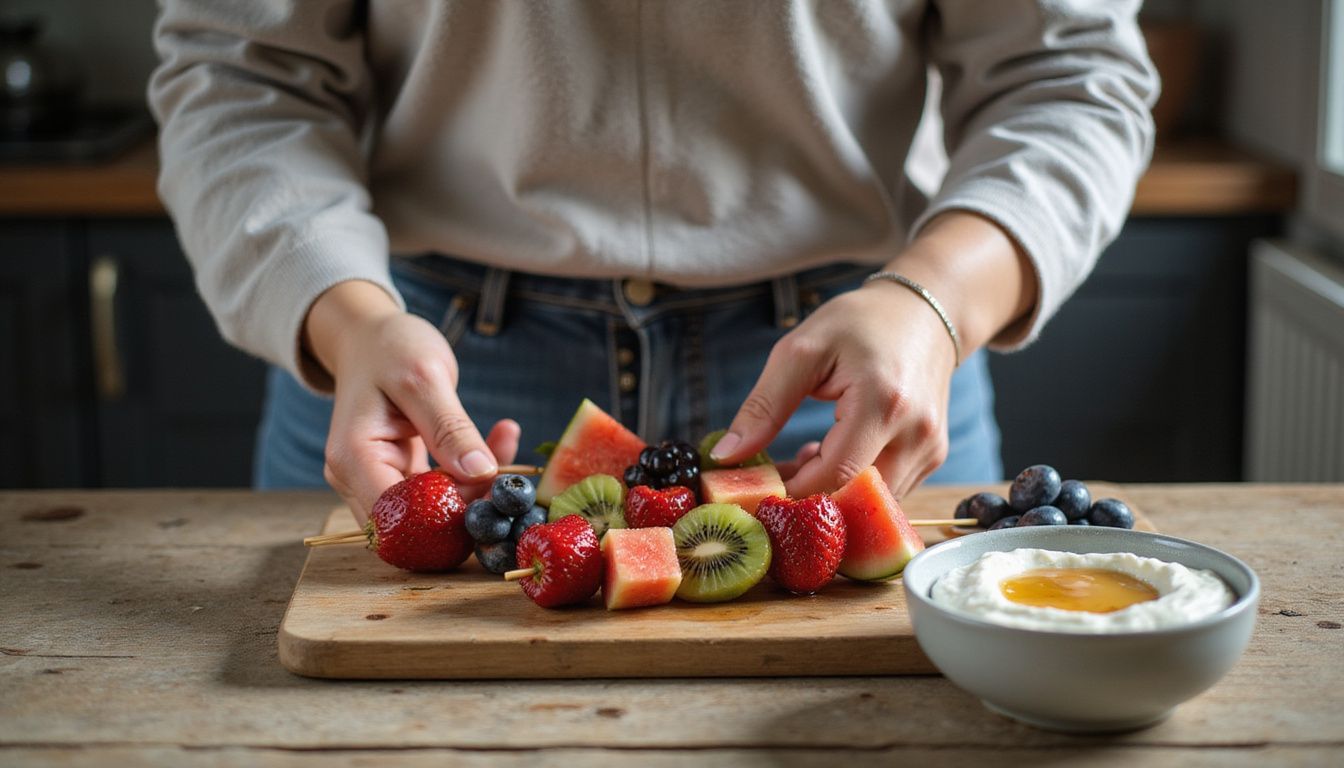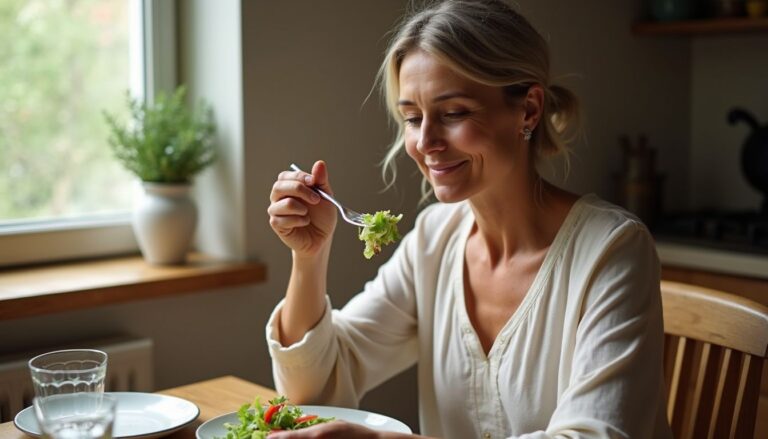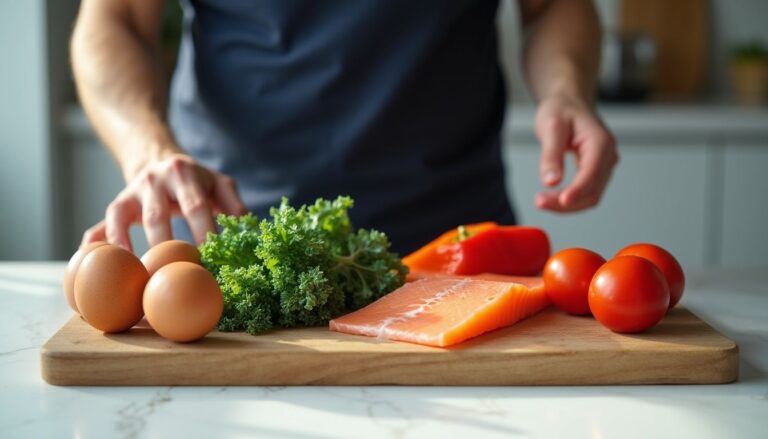Delicious Healthy Low-Calorie Snack Ideas Under 100 Calories
Our Nutrition Assistant AI Suite will transform your body. You will lose fat, get toned, and build muscle. Gain confidence and optimal health.
You might want simple ways to crush hunger between meals without blowing your goals. Low-calorie snacks help you stay on track with flavor, not extra fat or sugar. Think creamy Greek yogurt with honey or a frozen banana pop that tastes like dessert and still fits under 100 calories.
In this guide, you will find 20 delicious snack ideas under 100 calories. Each option is quick, balanced, and designed to help you build a healthier snack routine.
Key Takeaways
- Low-calorie snacks under 100 calories, like nonfat Greek yogurt with honey or apple slices with peanut butter, add protein and fiber that help you feel full between meals.
- Portion control matters. Use measuring cups or a kitchen scale, since six cups of air-popped popcorn equal about 100 calories and provide 6 grams of fiber.
- Choosing whole foods over ultra-processed snacks supports weight and heart health by lowering saturated fat and sodium in your day.
- High-protein picks, such as half a cup of cottage cheese with cantaloupe, deliver about 14 grams of protein for muscle support and satiety at roughly 100 calories.
- Research links higher fiber or protein intake with steadier blood sugar, better Type 2 diabetes outcomes, and lower risk of chronic disease.
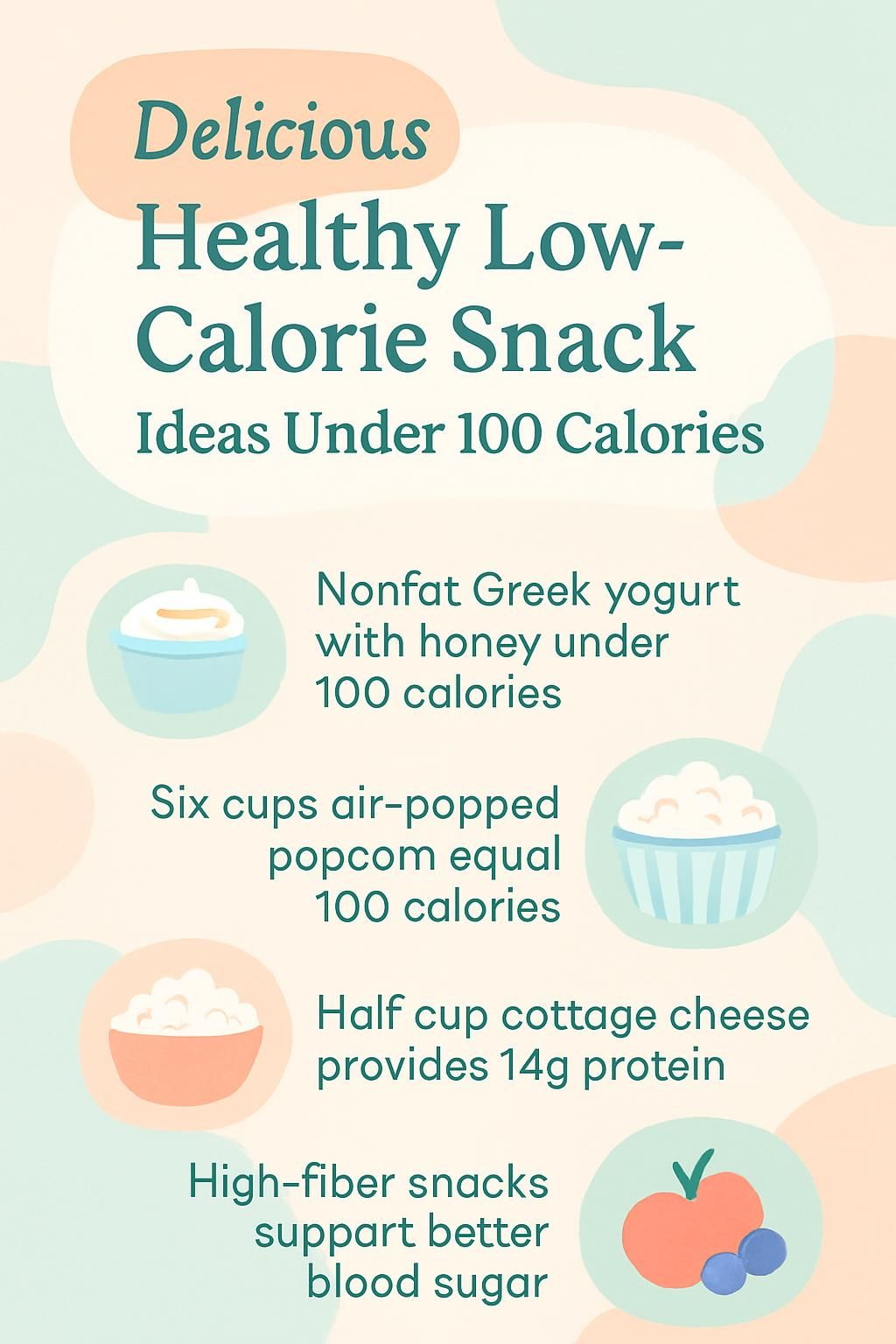
Why Are Low-Calorie Snacks Important for a Healthy Diet?
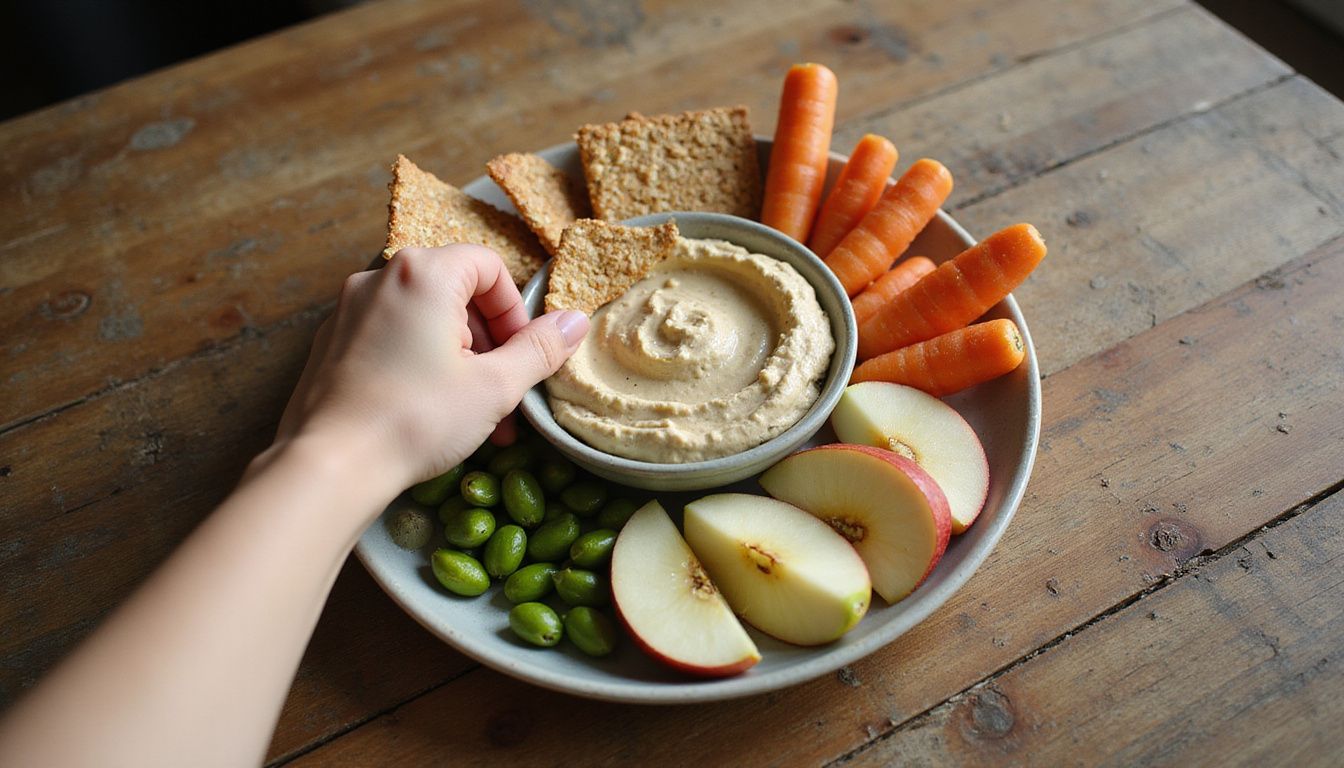
Smart snack choices shape your energy and your health. Keeping snacks to 100 calories or less can bridge the gap between meals without unwanted weight gain.
Whole foods like whole-grain crackers, baby carrots with hummus, apple slices, or edamame deliver vitamins, minerals, protein, and fiber with a modest calorie count. They also tend to have fewer additives.
Highly processed snacks, such as refined-flour crackers or high-fat cookies, often pack sodium and saturated fat. Swapping in fruit, vegetables, or cottage cheese supports heart health and daily nutrition. The American Heart Association and USDA highlight these patterns in their guidance for balanced eating.
Higher protein intake can aid weight management and support better blood sugar control in Type 2 diabetes. Choosing steady, nutrient-rich snacks helps reduce blood sugar spikes and keeps energy even.
Tips for Choosing Snacks Under 100 Calories
Smart choices keep calories in check and energy stable. Use these tips to make each small snack count.
How Can I Prioritize Whole, Nutrient-Dense Foods?
Focus on whole foods, which are foods close to their natural form. Fresh fruit, vegetables, plain yogurt, nuts, and seeds deliver more nutrients per bite than processed options.
Research links nutrient-dense choices to better heart health and weight control. Blueberries offer antioxidants that protect cells. Edamame brings plant protein with fiber for fullness.
Prep simple snacks at home, such as cherry tomatoes, cucumber sticks, or kale chips baked with olive oil and garlic. Homemade snacks let you limit added sugar, oil, and sodium.
Small swaps help. Try whole-grain crackers instead of refined ones, or baby carrots with hummus instead of chips. I made this change at work and noticed steadier energy and fewer cravings.
What Are the Benefits of High-Fiber and High-Protein Snacks?
Fiber slows digestion, so you stay full longer. For example, 6 cups of air-popped popcorn provide 6 grams of fiber at around 100 calories. Regular fiber intake also supports healthy digestion.
Protein helps repair muscle and curbs hunger. A half cup of nonfat Greek yogurt has about 12 grams of protein. One-third cup of edamame gives about 8 grams of protein and 4 grams of fiber, a great one-two punch.
High-fiber or high-protein snacks can steady blood sugar between meals. That can be helpful for people managing Type 2 diabetes. In my routine, low-fat cottage cheese or roasted chickpeas carry me through late-day cravings without overshooting calories.
How Do I Control Portion Sizes Effectively?
Measure snack servings with cups or a food scale. Pre-portion foods like cottage cheese, oat squares, or dried fruit to avoid mindless refills.
Place servings in small containers instead of eating from a large bag. Single-serve packs of strained yogurt or edamame make it even easier.
Portioning out snacks ahead of time made it easier to avoid mindless munching after school,a friend told me.
Stick to listed serving sizes. For example, half a cup of cottage cheese delivers protein and calcium within your calorie goal. Pair whole-grain crackers with a thin layer of low-fat cheese or cream cheese for flavor without excess fat.
These simple steps help you enjoy foods rich in fiber and protein while staying within your calorie target.
Sweet Low-Calorie Snack Ideas
Have a sweet tooth? You can satisfy it with smart picks that keep calories low and nutrients high.
What Are Some Sweet Snacks Under 100 Calories?
Choose simple, nutrient-dense treats that taste great and still fit your plan.
- Apple slices with 2 teaspoons unsalted peanut butter, about 90 calories. You get fiber plus healthy fats.
- Nonfat Greek yogurt, 1/2 cup, with 1 teaspoon sunflower seeds, under 100 calories. Protein and crunch with no cholesterol.
- Frozen mango cubes, 3/4 cup, about 90 calories. No saturated fat or cholesterol and roughly 60 percent of daily vitamin C.
- Blueberry smoothie with half a banana, berries, and water. It is rich in antioxidants with gentle sweetness.
- Baked apple with cinnamon, under 100 calories. Warm flavor and fiber with no added fat.
- Dark chocolate-drizzled strawberries. Two medium strawberries with a light drizzle meet the 100-calorie cap.
- Yogurt bark made with Greek yogurt and mixed berries. Freeze, then break into pieces for a protein-rich dessert.
- Healthy flapjack bars with mashed banana, dates, oats, sunflower spread, and vanilla. Sweet and filling without refined grains.
- Trail mix in a mini portion. Combine a few nuts with dried fruit for quick energy within the limit.
These ideas use whole foods like berries, apples, nuts, oats, yogurt, sunflower seeds, dates, bananas, and spices to raise nutritional value while staying light on calories.
Apple Slices with Peanut Butter
Pair 3/4 cup of apple slices with 2 teaspoons of unsalted peanut butter for about 90 calories. Apples bring fiber and natural sweetness. Peanut butter adds protein and healthy fat for staying power.
Keep portions small to stay under 100 calories. This simple combo balances taste and nutrition with very little saturated fat and no cholesterol.
Nonfat Greek Yogurt with Honey
Try half a cup of nonfat plain Greek yogurt with one teaspoon of honey, about 84 calories. You get 12 grams of protein, very little sodium, and no saturated fat.
This snack delivers calcium and a touch of natural sweetness. Plain yogurt keeps added sugars low compared with many flavored cups. I grab this during busy afternoons because it tastes like a treat and still fits my calorie goal.
Frozen Banana Pops
Slice half a ripe banana and dip the pieces into 1 ounce of low-fat yogurt. Freeze for two hours until firm. Each serving has fewer than 80 calories and minimal saturated fat and sodium.
These pops give natural sweetness and potassium from the fruit, plus a little protein from the yogurt. Keep a few in the freezer so you have a cool, low-calorie dessert ready anytime.
Blueberry Smoothie
Blend 1/3 cup nonfat yogurt with 2/3 cup frozen blueberries for a smoothie under 100 calories. There is no saturated fat, and sodium and cholesterol stay very low.
You get calcium, fiber, and vitamin C. Blueberries are rich in antioxidants that support overall health. This quick drink is easy to portion and great between meals.
Baked Apples with Cinnamon
Baked apples with cinnamon make a wholesome snack under 100 calories. Apples have almost no saturated fat and provide fiber, vitamin C, and potassium.
Sprinkle cinnamon before baking for extra flavor without extra calories. This warm, satisfying snack can support heart health and steady hunger.
Dark Chocolate-Drizzled Strawberries
After a warm baked apple, you may want something cool. Drizzle about five medium strawberries with one teaspoon of melted dark chocolate to stay under 100 calories.
Strawberries add fiber and vitamin C. Dark chocolate brings flavanols, plant compounds linked with healthy blood vessels, especially in moderate amounts [1]. This snack feels indulgent and still keeps sugar and fat in check.
…
[1] Harvard T.H. Chan School of Public Health, The Nutrition Source, Chocolate.
Savory Low-Calorie Snack Ideas
Crave something salty or spicy? These options deliver big flavor while staying under 100 calories.
What Are Tasty Savory Snacks Under 100 Calories?
Here are satisfying savory snacks that fit your goals.
- Edamame, steamed or roasted. One-third cup gives plant protein, fiber, and savory umami under 100 calories.
- Baby carrots with hummus. Six carrots with one tablespoon hummus are about 70 calories with fiber and vitamins.
- Bell pepper “sandwiches” with light cream cheese. Two pepper strips filled with one tablespoon light cream cheese are around 60 calories.
- Kale chips baked at home. Toss leaves with one teaspoon olive oil and black pepper, then bake for about ten minutes. One cup is about 50 calories.
- Roasted chickpeas, lightly seasoned. A quarter-cup serving has fewer than 100 calories and over 3 grams of fiber.
- Three whole-grain crackers with low-fat cheese. About 100 calories with fiber, calcium, and protein.
- Cheese-stuffed pita pockets. Use half an ounce of part-skim ricotta inside a small whole-grain pita for less than 100 calories.
I often pick baby carrots with hummus after school. It takes minutes to pack and keeps me full until dinner.
Edamame (Steamed or Roasted)
One-third cup of edamame is about 100 calories, with roughly 8 grams of protein and 4 grams of fiber. Saturated fat and cholesterol stay very low.
Roasting adds crunch that can replace salty chips. Sprinkle with a pinch of sea salt, chili powder, or vinegar for more flavor.
Baby Carrots with Hummus
Enjoy eight baby carrots with two tablespoons of hummus for about 100 calories. This serving has very little saturated fat and no cholesterol.
Carrots deliver vitamin A for eye health. Hummus provides plant protein from chickpeas, which fits vegan diets. It is a quick, packable snack that gives crunch and creaminess together.
Cucumber Slices with Guacamole
Cucumber slices are very low in calories because of their high water content. They are also refreshing after a long day.
Two tablespoons of guacamole add healthy fats from avocado and about 50 calories. Pair six to eight cucumber slices with guacamole to stay under 100 calories. You also get potassium and vitamin C.
Bell Pepper “Sandwiches” with Cream Cheese
Slice bell peppers into rings or strips and spread a thin layer of low-fat cream cheese. This snack stays under 100 calories per serving with crisp texture and bright color.
Bell peppers provide vitamin C and fiber. It is a gluten-free option that feels light but still satisfying, great for busy afternoons.
Kale Chips
If you want crunch without heavy calories, bake kale chips at home. Use 100 grams of kale with two minced garlic cloves and one tablespoon of oil.
Roast at 200°C, about 400°F, for 12 to 15 minutes until crisp. Kale brings fiber, vitamin K, and antioxidants. Making them yourself limits oil and salt.
Roasted Chickpeas
Roasted chickpeas are another crunchy pick. Toss 400 grams of chickpeas with one teaspoon of oil and spices, then bake for about 35 minutes.
Keep portions small, about two tablespoons, to stay under 100 calories. Each bite brings fiber, protein, and a nutty taste that satisfies salty cravings.
Protein-Packed Low-Calorie Snacks
Protein helps you feel full longer and supports muscle health. These quick bites deliver protein without pushing past 100 calories.
Which Low-Calorie Snacks Are High in Protein?
Here are simple options that are easy to prep and carry.
- Hard-boiled egg, about 6 grams of protein and fewer than 80 calories. Add a pinch of salt or spices.
- Nonfat Greek yogurt, 1/2 cup, about 12 grams of protein at roughly 84 calories. Choose plain to limit added sugar.
- Smoked salmon pinwheels with 1 tablespoon light cream cheese on one salmon slice, under 60 calories per roll-up.
- Cottage cheese with cantaloupe, about 14 grams of protein in half a cup at around 100 calories.
- Edamame, one-third cup, around 8 grams of protein at 100 calories.
- Canned white tuna, drained, about 90 calories for two ounces. Easy to store and use.
- Turkey and cheese roll-ups with one thin slice of turkey and half an ounce of mozzarella, less than 70 calories total.
I often pack nonfat Greek yogurt on busy days. It fills me up without slowing me down in the afternoon.
Hard-Boiled Eggs with a Pinch of Salt
One hard-boiled egg has about 70 calories and more than 6 grams of complete protein. You also get vitamin D, choline, and selenium.
For extra flavor, add a spoonful of Greek yogurt with curry powder or a squeeze of lemon juice. This simple snack is portable and keeps well in the fridge.
Turkey and Cheese Roll-Ups
Layer one slice of turkey breast with a thin slice of low-fat cheese. You get more than 8 grams of protein while staying under 100 calories.
Lean turkey cuts down fat compared with other deli meats. This is a handy option for work breaks, road trips, or school lunches.
Cottage Cheese with Cantaloupe
Pair 1/2 cup low-fat cottage cheese with a small wedge of cantaloupe. This snack has about 14 grams of protein and stays under 100 calories.
Cottage cheese brings calcium. Cantaloupe adds hydration and vitamin A. The creamy-sweet combo is refreshing and filling.
Smoked Salmon Pinwheels
Spread 1 tablespoon of low-fat cream cheese on one slice of smoked salmon. Roll and cut into bite-sized pieces. Two pinwheels stay under 100 calories.
Salmon supplies protein and omega-3 fats that support heart health. The light cream cheese adds creaminess without much saturated fat. They make a fast, elegant snack for home or work.
Crunchy Low-Calorie Snack Options
If crunch is your thing, you have several low-calorie ways to get that satisfying bite.
What Crunchy Snacks Can I Eat Under 100 Calories?
These crunchy choices help manage cravings and keep portions in check.
- Six cups of air-popped popcorn, about 100 calories, 6 grams of fiber, and only 0.5 grams saturated fat.
- Dry oat squares cereal in a small measured portion. Easy to track and easy to munch.
- Rice cakes with a thin layer of nut butter. Use about a teaspoon to stay under 100 calories.
- Roasted chickpeas, made from 400 grams chickpeas and one teaspoon oil, baked for about 35 minutes.
- Whole-grain crackers with cheese. Three crackers plus a small slice of low-fat cheese land near 100 calories.
- Six whole-grain pretzel sticks for exactly 100 calories, with over 3 grams of fiber.
- Cinnamon popcorn using 50 grams popcorn kernels with two teaspoons oil and cinnamon for a sweet crunch.
Keeping a small bag of these in your desk or backpack can stop random hunger without weighing you down.
Air-Popped Popcorn
Air-popped popcorn gives volume for very few calories. Six cups have about 100 calories and 6 grams of fiber with no cholesterol.
It is a naturally gluten-free whole grain. Season with herbs or spices to add flavor without adding butter.
Whole-Grain Crackers with Cheese
Combine three whole-grain crackers with a slice of low-fat cheese for about 100 calories. You also get fiber, protein, and calcium.
Counting three crackers keeps portions simple. I like this on busy afternoons because it takes less than a minute to prepare.
Rice Cakes Topped with Nut Butter
One plain rice cake has about 35 calories. Spread one teaspoon of almond or peanut butter for flavor, healthy fats, and a small protein boost.
Choose unsweetened nut butters to limit sugar and sodium. Add a few banana slices for a sweet bite, or a pinch of sea salt for savory taste, while staying under 100 calories.
Dry Oat Squares Cereal
Measure 1/3 cup of dry oat squares for about 70 calories. This whole-grain snack is low in saturated fat and sodium.
Pack a small container for on-the-go crunch. It is tidy, portable, and easy to portion.
Fruity Low-Calorie Snacks
Fruit snacks bring natural sweetness, hydration, and color to your plate.
What Are Refreshing Fruit Snacks Under 100 Calories?
These fruit-forward options are fresh, fast, and filling.
- Grapes, 1 cup, about 100 calories and very low saturated fat. Good source of vitamin K and manganese.
- Watermelon cubes, 1 cup, under 50 calories with high water content for hydration.
- Frozen mango cubes, 3/4 cup, about 90 calories and around 60 percent of daily vitamin C.
- Apple slices, one small apple, about 80 calories with fiber. Add a whole-grain cracker for crunch.
- Fresh strawberries, eight medium, about 50 calories and rich in vitamin C.
- Pear slices, half a medium pear, about 50 calories with filling fiber.
- Watermelon and feta salad, half-cup serving under 100 calories with protein and tang.
- Frozen grapes, pre-portioned snack packs that add a fun texture while delivering antioxidants.
Grapes (1 Cup)
One cup of grapes has about 100 calories with almost no saturated fat or sodium. They contain water and fiber that help you feel full.
Portion them in a measuring cup to keep the serving size on track. They travel well and require no prep.
Watermelon and Feta Salad
Watermelon has about 46 calories per cup and a high water content that supports hydration, according to USDA FoodData Central. One tablespoon of crumbled feta adds calcium and protein while keeping the snack under 100 calories.
The sweet and salty pairing feels special while still fitting a healthy plan. A sprinkle of fresh mint or black pepper boosts flavor without adding calories. Nutrition educators often recommend water-rich fruit for balanced snacks.
Frozen Mango Cubes
Enjoy 3/4 cup of frozen mango cubes for about 90 calories. There is no saturated fat or sodium, and you get vitamin C and fiber.
Freezing changes the texture for a cool treat that calms a dessert craving. Keeping a bag of frozen mango on hand makes healthy snacking easier.
Creative Low-Calorie Snack Ideas
Shake up your routine with flavorful ideas that keep snacks interesting and light.
What Are Some Unique Low-Calorie Snack Ideas?
These creative options deliver color, texture, and nutrition under 100 calories per serving.
- Beet hummus: blend 85 grams chickpeas, one cooked beet, two teaspoons olive oil, four teaspoons lemon juice, and black pepper. Serve with crunchy veggies.
- Yogurt bark: mix 500 grams Greek yogurt with 150 grams fresh berries. Spread, freeze, then break into pieces.
- Curried eggs: mash one hard-boiled egg with a tablespoon of Greek yogurt, curry powder, garlic powder, lemon juice, and mint.
- Kale crisps: roast 100 grams kale with minced garlic and one tablespoon oil at 200°C, about 400°F, for 12 to 15 minutes.
- Healthy flapjack bars: combine mashed bananas, chopped dates, oats, sunflower spread, and vanilla for a naturally sweet bite.
- Baked samosas: fill filo pastry with sautéed shallots, garlic, chili, spices, potato, peas, and chickpeas; brush with one teaspoon oil and bake for twenty minutes.
- Salmon pâté: blend 225 grams poached salmon with one tablespoon horseradish sauce and one teaspoon lemon zest. Add herbs and serve chilled on whole-grain crackers.
- Loaded rice cake: top one rice cake with two tablespoons cottage cheese, six cherry tomatoes, and fresh basil.
Chia Pudding with Almond Milk
Combine 1 tablespoon chia seeds with 1/2 cup unsweetened almond milk for about 60 calories. Chia seeds provide fiber, plant protein, and omega-3 fats.
Stir and chill overnight for a creamy pudding texture. Keep toppings light, like a few berries or a dash of cinnamon, to stay under 100 calories. Fiber-rich foods like chia can increase fullness, according to Harvard T.H. Chan School of Public Health.
Tomato and Mozzarella Jars
Layer five halved cherry tomatoes with three mini mozzarella balls and a few basil leaves. This portable snack stays under 100 calories.
Tomatoes supply vitamin C and antioxidants. Mozzarella adds protein and calcium. Finish with a teaspoon of balsamic or olive oil if it fits your calories.
Apple and Almond Butter Rounds
Slice a small apple into thin rounds and top each with 1/2 teaspoon almond butter. Use less than one tablespoon total to stay under 100 calories.
Apples add fiber and vitamin C. Almond butter brings healthy fats and a touch of protein. I often make these for an afternoon lift that does not cause an energy crash.
Jicama Sticks with Salsa
Cut one cup of jicama into sticks and pair with fresh salsa. This crunchy combo has around 54 calories and almost no saturated fat.
Jicama is high in water and fiber, which supports fullness. Salsa adds big flavor with very few calories.
Benefits of Incorporating Low-Calorie Snacks
Adding low-calorie snacks to your day can improve control, reduce cravings, and upgrade nutrition.
How Do Low-Calorie Snacks Help Prevent Overeating?
Small, balanced snacks help you feel full, so you arrive at meals less hungry. Protein and fiber slow digestion and reduce spikes and crashes in blood sugar.
Whole fruits and vegetables add vitamins and minerals for minimal calories. Healthy fats from nuts or peanut butter boost satisfaction in small amounts. Prepping snacks at home helps you control ingredients and portions.
Can Low-Calorie Snacks Satisfy Cravings Without Guilt?
Yes, smart choices can hit the spot and support your plan. Options rich in protein or fiber, like cottage cheese with cantaloupe or a cup of air-popped popcorn, tame hunger longer.
People who pick nutrient-dense, low-calorie snacks often report less regret after eating [2]. Whole foods such as nonfat Greek yogurt with honey or baked apples with cinnamon offer natural sweetness plus useful nutrients.
[2] Drewnowski A et al. Energy density, palatability, and satiety: Implications for weight control. Nutr Rev. 1997;55(6):152-61.
How Do These Snacks Provide Sustained Energy?
Balancing protein, fiber, and healthy fat helps your body release energy slowly. Greek yogurt with honey, for example, brings protein and carbs that digest at a steady pace.
Fiber from popcorn or whole-grain crackers slows digestion and prevents sudden drops in energy. Pair fruit with nuts or dairy to blunt sugar spikes and keep you satisfied.
USDA food patterns highlight the value of combining these nutrients at meals and snacks. On busy days, I pack apple slices with peanut butter. It keeps me fueled until dinner.
Conclusion
Choosing delicious, healthy low-calorie snacks under 100 calories can support your goals without losing flavor. Mix sweet, savory, crunchy, and protein-packed options to stay satisfied throughout the day.
Use simple portion tools, favor whole foods, and keep a few go-to ideas ready. Small, steady choices build better energy and a healthier routine. This article offers general nutrition guidance. If you have a medical condition, talk with a registered dietitian or your healthcare provider for personal advice.
FAQs
1. What are some healthy snack ideas under 100 calories?
Fresh fruit like strawberries or blueberries, raw vegetables such as carrot sticks, and a small handful of almonds each offer snacks under 100 calories. According to the USDA FoodData Central, one cup of sliced strawberries contains about 53 calories while ten baby carrots have around 35 calories.
2. How can I make sure my low-calorie snacks are nutritious?
Choose whole foods with fiber and protein for better satiety. For example, pairing apple slices with cottage cheese provides both nutrients in less than 100 calories per serving. Research from Harvard T.H. Chan School of Public Health shows that high-fiber foods help control hunger and support digestive health.
3. Are packaged low-calorie snacks as healthy as fresh options?
Many packaged items contain added sugars or sodium even if they advertise fewer than 100 calories per serving. The Centers for Disease Control and Prevention recommends reading nutrition labels to check for hidden ingredients that may reduce overall nutritional value.
4. Can you share a personal tip for choosing satisfying snacks under 100 calories?
I often prepare small portions ahead using clear containers so I can see what is available when cravings strike; this helps me avoid overeating by sticking to measured servings like Greek yogurt topped with berries or air-popped popcorn.
Summary: Healthy snack choices under 100 calories include fruits, vegetables, nuts, dairy products like yogurt, and simple homemade mixes prepared in advance. Selecting nutrient-dense foods supports energy levels without excess sugar or salt intake according to leading nutrition research organizations.

